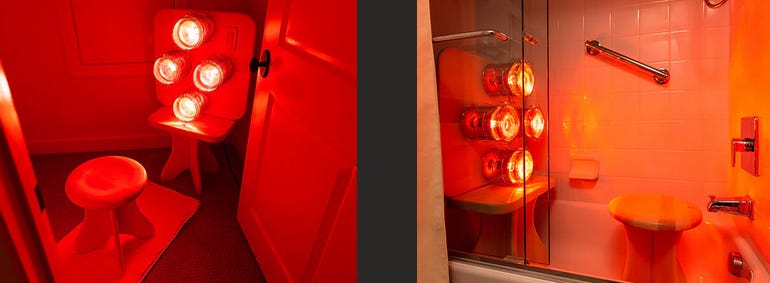Melatonin & Vision Loss

Here’s what we’ll learn in this article:
1. Why is melatonin not the hormone of darkness?
2. How do our bodies make melatonin?
3. Why is dopamine important for our vision?
4. Why does our vision decline with age?
4. Two studies cautioning against melatonin supplements
5. What is subcellular melatonin?
6. How does near infrared help protect us against EMF?
7. How does near infrared light regenerate our brain?
8. Why do pregnant mothers need near infrared light?
9. How can we optimize near infrared light in winter?
“If you want to be reborn, let yourself die. If you want to be given everything, give everything up.”
~ Lao Tzu
In the eye of the storm, we lose sight of the bigger picture, only to recognize the tattered facades and reckon with the wreckage of our choices after the whirlwind. Our country’s capital of health once sat upon a shining hill, but its pillars of vitality now crumble to the sea.
We’ve built sand castle factories in the sky that down pills on us like candy, all the while disregarding the machinery of Nature.
We’ve forgotten how to embrace the cold drizzle, and seek shelter in the warmth of our captor’s palace instead. All the while magical mists of forlorn rainbows desperately yearn to enfold us in their resplendent robes of glory. Failing to feed on divine light, we starve our restless sanity in a devil’s dark.
Each night as we lay down to rest, we replenish the fog of our stressful day with hormonal rainbows of our own. Hormones are chemical messengers that tell our bodies when and how to eat, pray, love, sleep, and breathe. These messengers get their instructions from the presence or absence of light. Dopamine thrusts us into action with the onset of the sunrise, and melatonin mellows us down with the moon. As the dark night marches on, melatonin floods the fields of our brain, and washes away the cellular debris we’ve accumulated during the day.
While many of us know of melatonin as the “dark hormone”, it’s actually the hormone of Sunlight as well. When we expose our skin and eyes to Sunlight, our bodies create subcellular melatonin, which acts as a potent antioxidant reservoir for the pineal melatonin we secrete at night. Melatonin is first produced by the eye, and then ocular (eye) melatonin helps liberate the melatonin in the pineal gland in response to the absence of light.
Our highest concentrations of melatonin are found in our eyes, which means the best way to “take” this supplement is by seeing it, not in the health food aisle, but over the counter of the morning horizon. Ocular melatonin uses morning light to regenerate our eyes’ melanopsin receptors, rods and cones in broad daylight using UV and IR (infrared) light.
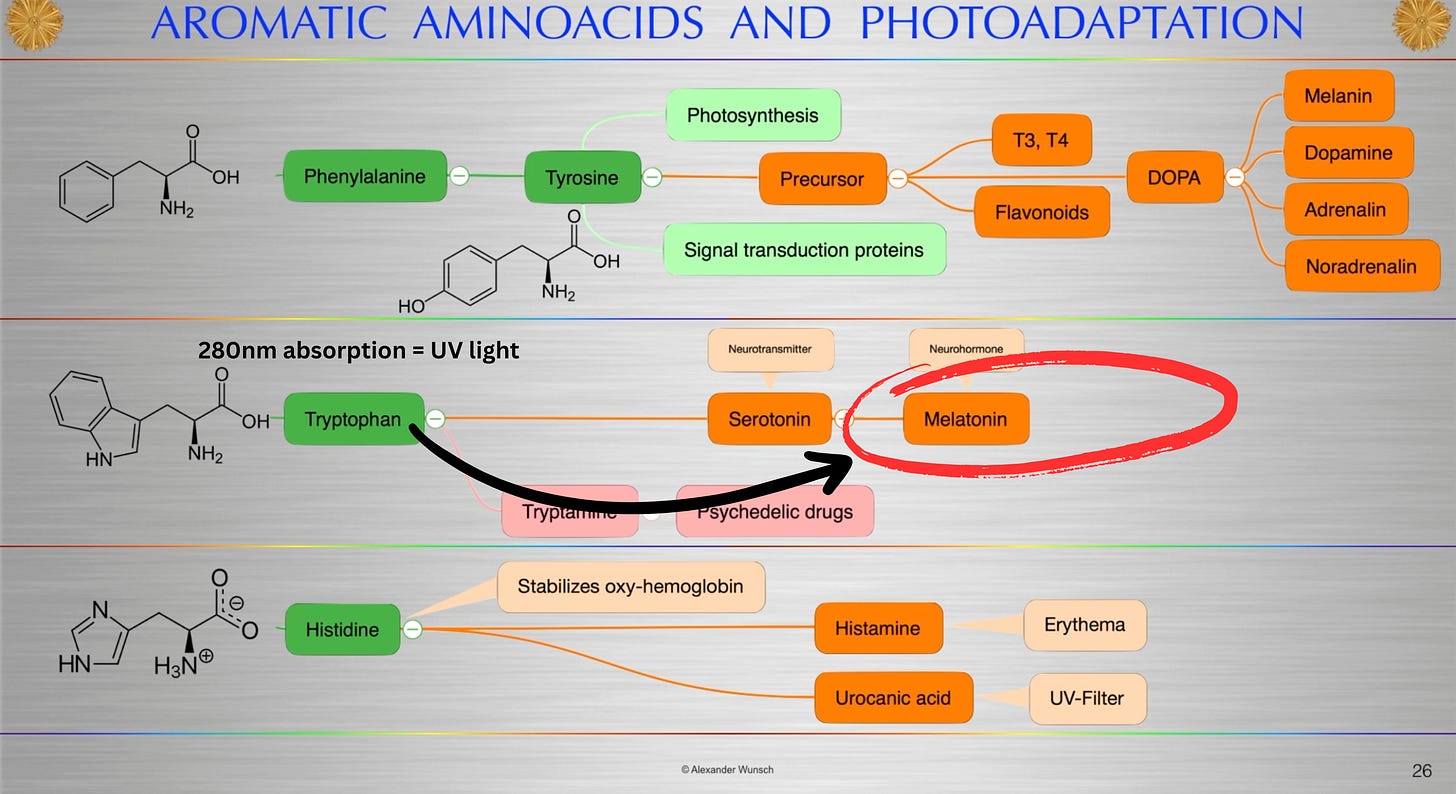
How is melatonin created in our body?
Melatonin production starts with tryptophan. Ultraviolet light (UV) gives tryptophan the energy to convert into melatonin. This leads to more serotonin being available. Natural light exposure in someone’s eye increases serotonin. When we take a pill, we’re not getting the benefit of this endogenous (produced by our body) serotonin. We don’t need SSRIs when we use our eyes.
The beauty of subcellular melatonin is that we create it by being exposed to near infrared light, without the presence of UV. Are we saying that you don’t need UV at all? No - we still need hormones like vitamin D that improve immunity during the colder months, and the best source of D is UV. Those of us in northern climates have very little UV, which is why we need to rely on foods rich in vitamins A & D.
If you do have any UV in your area (we have it at level 1 where we live) get out for at least 5 minutes and get it into your eye.* It’s always best to first see the morning light at Sunrise, as these wavelengths are gentler on the eye, and help regenerate your retina with red light at that time.
Subcellular melatonin could have been an adaptation our northern ancestors developed to remain healthy in the absence of Sunlight during the winter months, as it is even able to reflect off surfaces like grass and snow. This is why we need to embrace the climate we live in, and get outside. Even the gloomiest winter day is ten times brighter than the modern office, and our eyes and mood can feel the difference when not exposed to natural light.
What happens to many of us during the winter? We huddle indoors most of the day, and as night approaches we pass the time, waiting to tire, but feel wired instead. Some of us take a melatonin supplement. While yes - this can be considered a “natural” supplement, wouldn’t it be more natural not to take something our body already makes?
Bohdanna and I appreciate that we’re all unique, and each of us requires certain interventions and supplements from time to time, but to take something we make is not a sustainable long-term strategy. When we try to bend the rules of Nature, we can wind up breaking the ruler of our health - our body.
The dark rainbow of our eyes
Since melatonin inhibits dopamine, if we take too much, or at the wrong time, we could potentially be creating a cascade of harm. On average, melatonin levels reach their peak four hours after darkness. What happens to our innate circadian rhythms, which dictate how our bodies function and repair, if we take melatonin orally too early, or too late, in the night? The answer to this question lies in melatonin’s dance partner - dopamine.
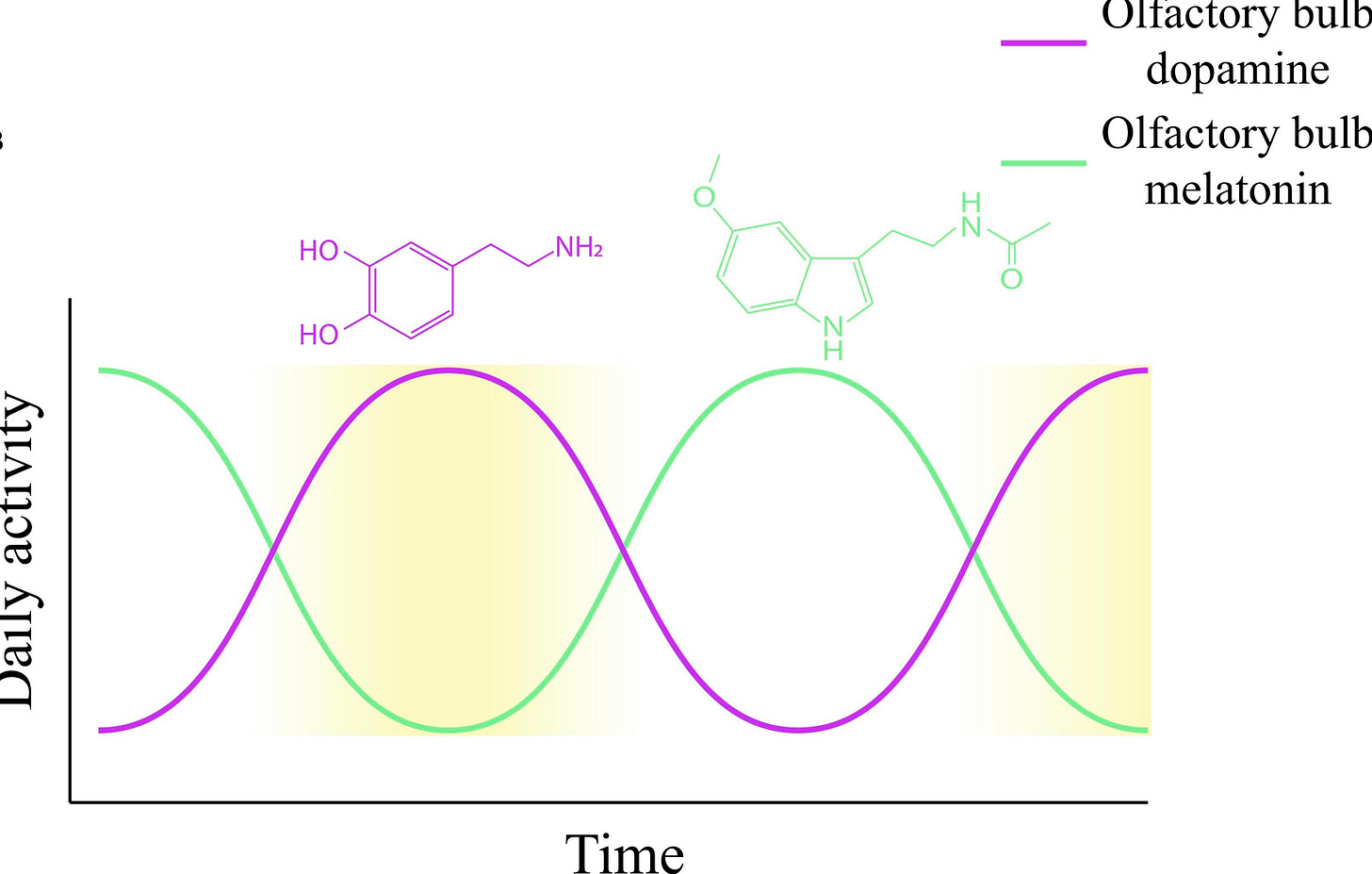
Although typically known as the “pleasure” hormone, dopamine is so much more than meets the eye. The cones of our eyes use dopamine to see color during the day. Dopamine regulates the pupillary light reflex, which controls the diameter of our pupil in response to the intensity of light that falls on the retina.3
When we enter the gym of Nature, our dopamine levels become optimized, and we can ward off disorders like myopia (nearsightedness), which we wrote about here.
A 2017 study in Progress in Retinal and Eye Research found that children who spend more time outside are less likely to develop myopia, due to naturally-increased levels of dopamine.
While cones detect precision and color in light, rods are receptive to motion and see in black and white. Cones give us more detailed information, but rods are far more sensitive. Rods are the reason we can see in the dark, detect the shape of objects in low levels of light, and give us our peripheral vision.
As we age, we lose both cones and rods. However, in many people, the degeneration of rods greatly outpaces the degeneration of cones.
Consider this: when we are born - our rods outnumber our cones by more than 10 to 1. In an autopsy studying older adults, it was found that by the time we pass away over one-third of our rods have died.5 The degeneration of rods is one of the reasons why older adults struggle to see at night.
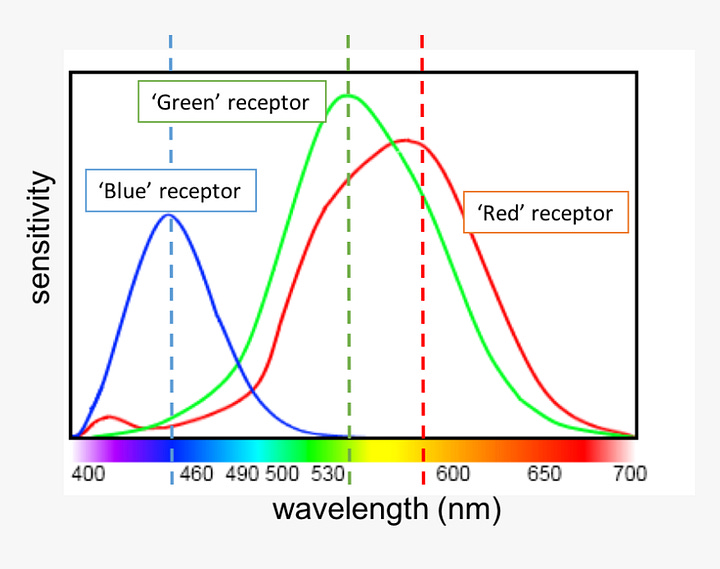
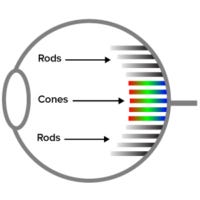
Two studies cautioning against oral melatonin
We recently came across two studies exploring the role of oral melatonin on eye damage. A 2009 study from The Journal of Circadian Rhythms found that oral melatonin, an inhibitor of retinal (made in the eye) dopamine, may disrupt the way our cones normally function. If our cones control how much light our pupils let in, and are not working properly, what happens if we expose ourselves to blue light at night? Could we be letting in even more torrents of a blue beam rainbow never meant to illuminate our world?
A 1992 study7 from The Journal of Investigative Ophthalmology & Visual Science found that oral melatonin thinned the retina of rats by ruining photoreceptor regeneration. Although humans are not rats, both species follow similar hormonal cycles. If we want to see the colors of the rainbow, then we have to let the rains of darkness wash over us from time to time.
The good news is: we can create a reservoir of melatonin that we can tap into all winter long by getting outdoors. New research is pointing to subcellular melatonin created in the mitochondria as a backup to the melatonin typically made by our pineal gland.
Mitochondria are the energy factory of our cells and absorb near infrared light (NIR) in order to produce melatonin. It’s now been shown that our mitochondria produce melatonin in quantities that are orders of magnitude higher than produced in the pineal gland (circulatory melatonin).
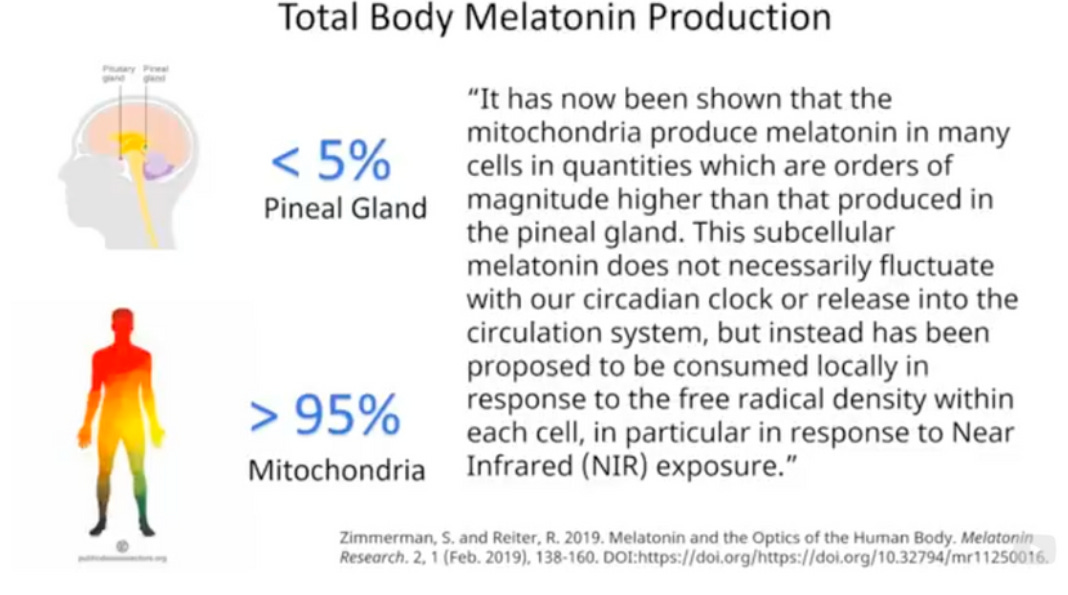
Instant gratification for our wireless intoxication
Levels of subcellular melatonin do not necessarily increase or decrease depending on the time of day or night, or release into our bloodstream in the traditional way as we do with pineal melatonin. Instead, subcellular melatonin is used up locally within each of our cells, when damage from free radicals (like those from EMF) occur. Getting outdoors is an excellent, low-cost tactic to offset the harmful effects of our cumulative exposure to wireless radiation from cell towers, satellites, and all those other toxins out of our immediate control.
Why is NIR so near to our health?
Since we blasted you with so much bad news about supplements, here’s some more good news: the light we need to generate subcellular melatonin is present all year round!
There are three types of infrared: near, mid, and far. Out of all the types of light we get from the sun, about 41% is near infrared, but because near infrared penetrates deeply into the body, over 70% of the Sun's power we absorb is near infrared:
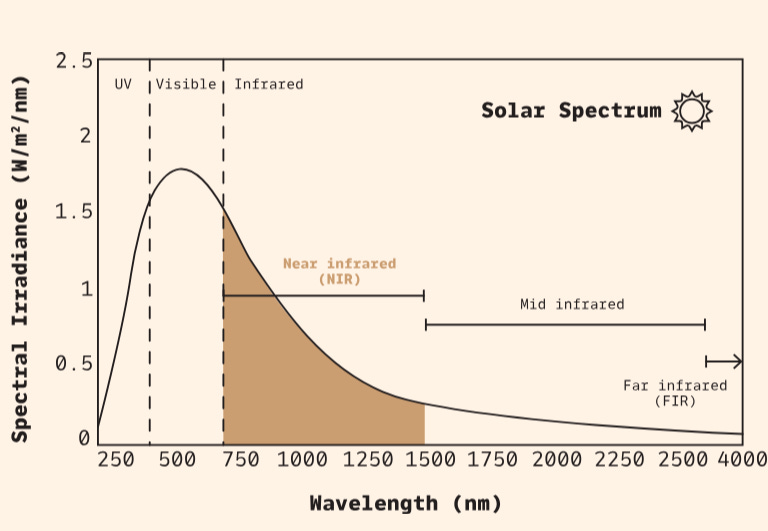
NIR photons, or subatomic particles of light, are scattered several inches into our body - even through the skull. Since wireless radiation can cause our blood brain barrier to leak, it’s good to know we can have a beneficial type of light sneaking past the guards of our ganglionic galaxy.
Infrared light has been shown to help wounds heal, improve outcomes of neurodegenerative diseases like Alzheimer’s, and treat macular degeneration.
Our brains are optically designed to distribute NIR photons into the grey matter, down to the innermost folds of our brain.
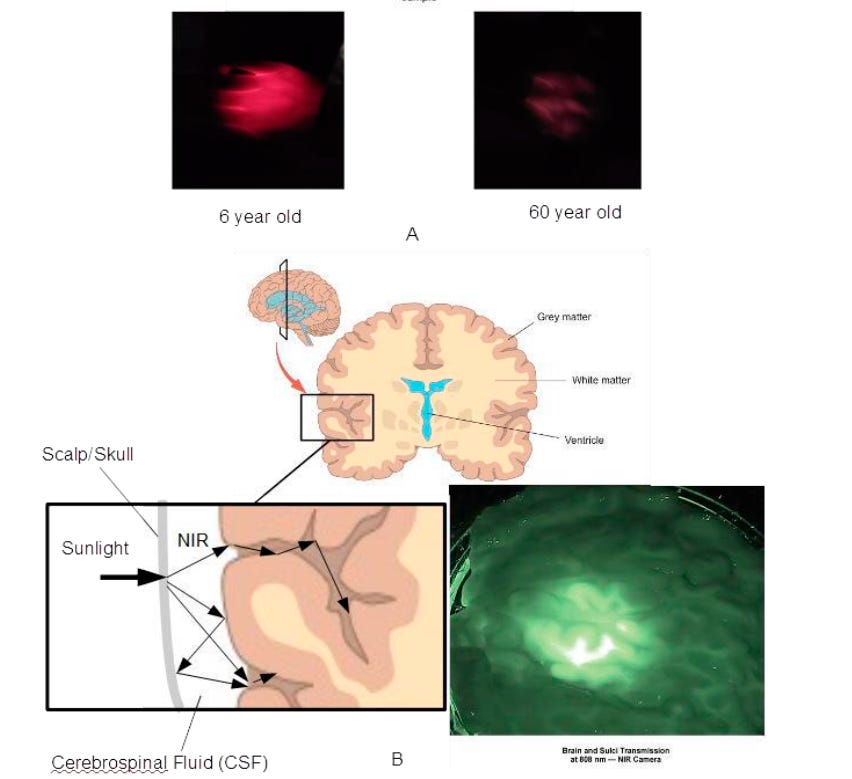
Our nervous system gets an oil change each night, as our cerebrospinal fluid (CSF) cleans up waste and cellular debris in the cavities of our brain. A crystal clear fluid, the CSF is able to scatter near infrared photons of light where needed, and operates similar to a car lamp (the ones from the 90s, not the sci-fi lasers we have today).
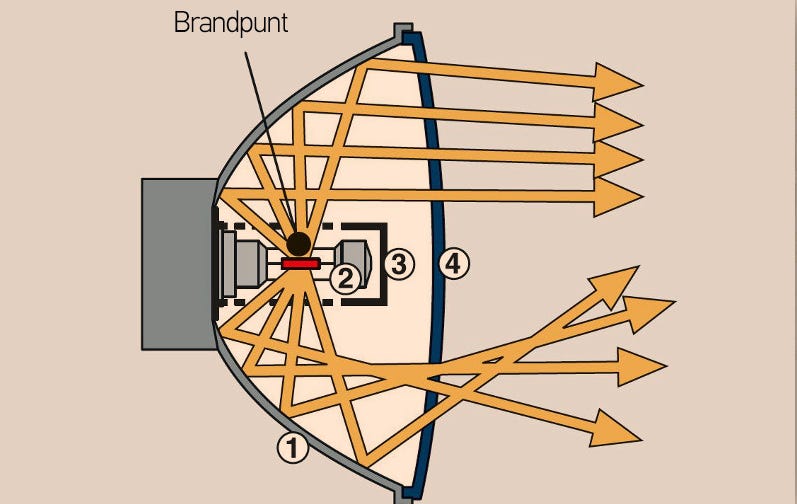
We can think of our CSF as a crystalline fluid that lights up our brain’s museum with infrared laser beams at night so that Tom Cruise can’t steal our treasure chests of healing, golden light.
Why is this important? When we create a subcellular reservoir of this light during the day, we emit NIR back into the brain cells that need it most.
Why pregnant mothers need Sunlight
Not only does NIR light penetrate our skull, it also shines right through the placenta and is absorbed by 100% of cells in a fetus.
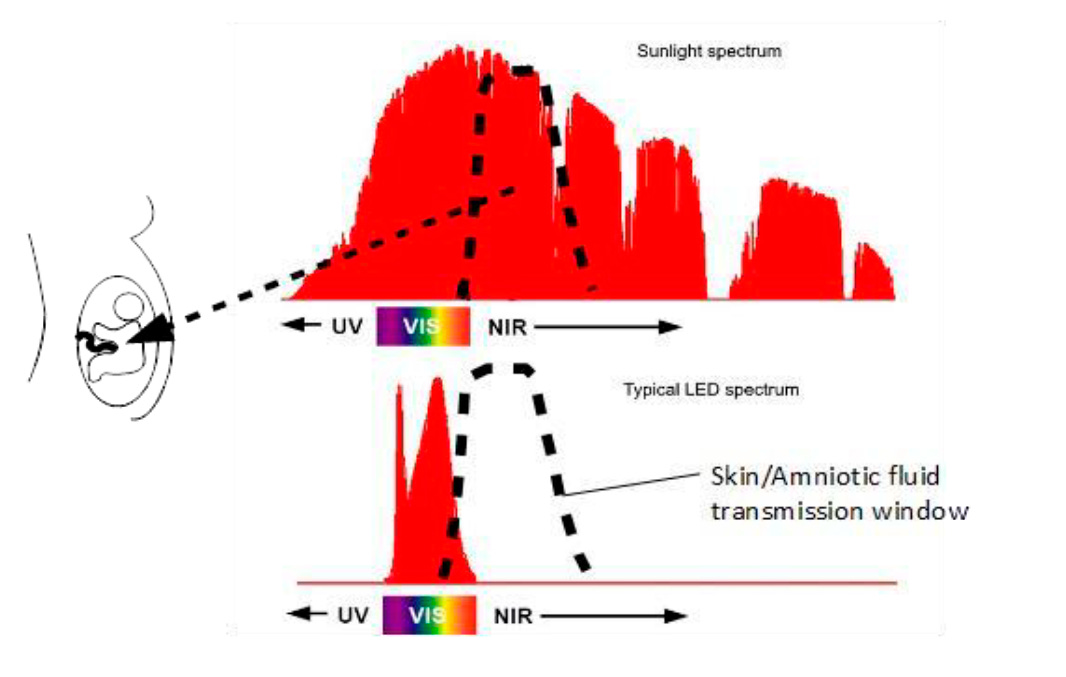
Amniotic fluid has been shown to have a peak transmission around the infrared wavelength of 850nm (nanometers), similar to the CSF fluid around the brain (as above).
When we expose ourselves to Sunlight, the subcellular melatonin we produce ensures that each healthy cell will be constantly refilling its own antioxidant stores.
How can we optimize NIR during winter?
Other than being outside for most of the day, there are a few tactics we can employ to give our moods, and bodies a boost.
Note: infrared light therapy is NOT a substitute for Sunlight.
Don’t think you can hide inside with the red light on, and skip out on natural light.
Your circadian rhythms will scold you for us.
If you’re one of our readers, then you know we love talking about red light.
Thanks to wonderful, engaged readers like you, it’s not just going to be us “talking” about light today. Recently
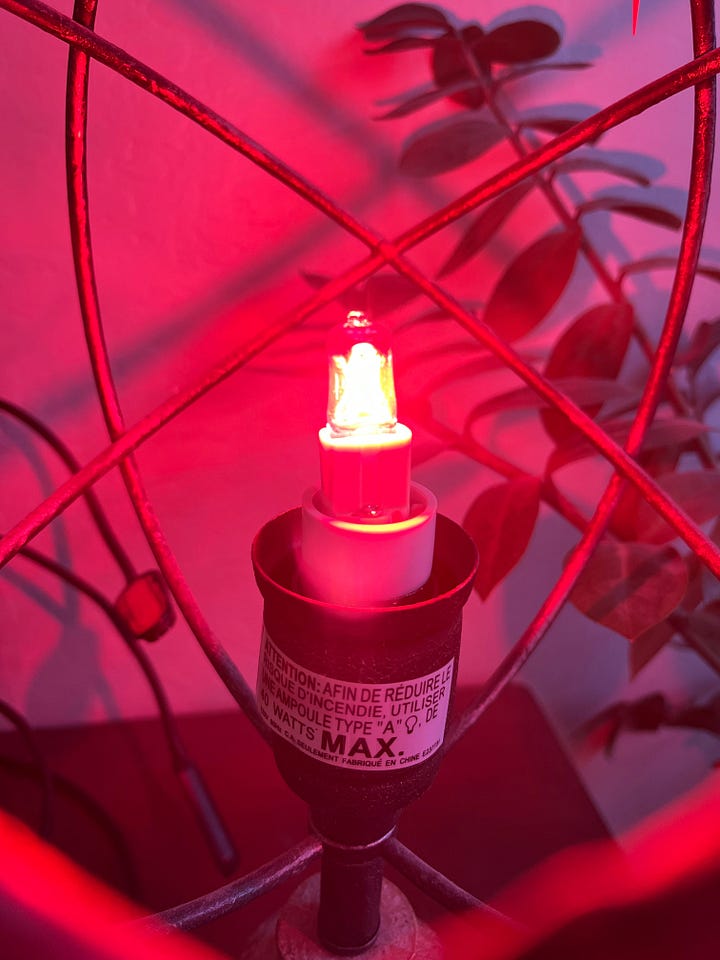
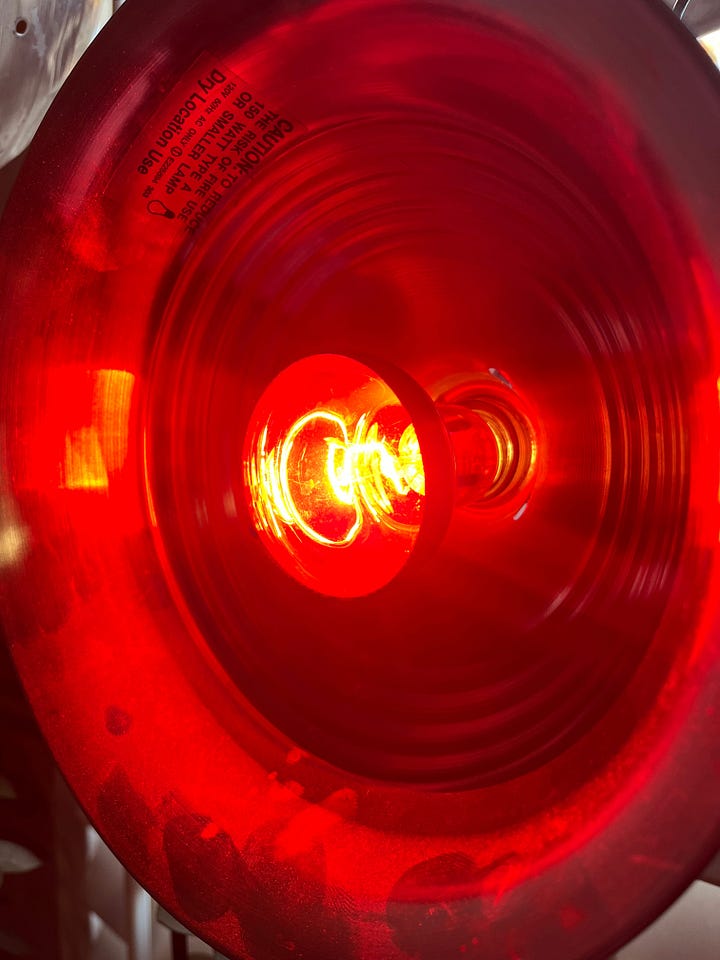
Use a red shield to ward off blue aliens
Wes also was able to give his car some circadian shielding in the form of red plexiglass.
This can be a decent option for anyone driving at night, or anyone in Canada, as daylight running lights have now turned into LED day-and-night running lights. LEDs in the blue spectrum are a problem because they inhibit melatonin secretion, especially at night.
These red shields say “you ain’t worth my time of day, or night.” Deflect, and live to deflect and fight another day is what I say:
I even went to the extent of taking red plexiglass and making cutouts to block the reflection from the side mirrors.
When I drive at night, I put a curtain in the rear window. I drive a lot for work, so this is what I call my “circadian armor .” LOL!
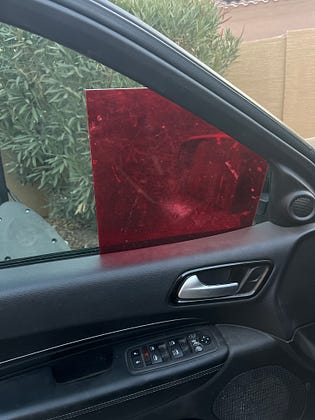
Wes was even courteous and compassionate enough to apply these to his lights:
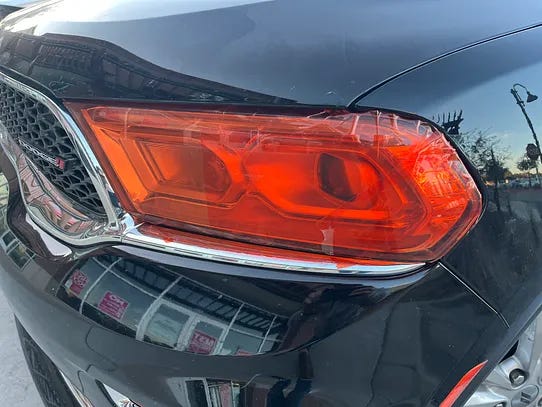
An eye for an eye makes the whole world blind, but saving an eye enlightens our future.
If you’d like to learn more tips around EMF protection, from shielding to how our light environment is changing, and what we can do about it, join us over at The Power Circle! There’s a community of like-minded EMF health nuts just like us, exchanging solutions and advice:
Turn up the heat with NIR light therapy
There are many options on the market when it comes to infrared therapy, some near, some far, and some mid-infrared. Each one has a unique impact on our physiology. However, near infrared penetrates the deepest, and thus has the greatest potential for regeneration and repair.
The other factor to consider is how the light we receive is being emitted - is it coming from an incandescent or LED? Incandescent bulbs radiate out from all directions like a sphere. Since our eyes and the Sun are a sphere, we’re optimally adapted to capture this type of light. LEDs, while they may offer specific, targeted therapeutic benefits, are not full spectrum like NIR, and have lasers that emit off a flat surface, rather than the curved, sphericial surface.
We are SaunaSpace affiliates, so while we do get credit for any products ordered from their site, we can say that after searching the internet far and wide, they are the best and brightest we’ve found. All products are made in-house at their factory in Missouri, which you can see in the video behind Brian.
This is a setup inspired by SaunaSpace that we’ll be installing:
As we head into the fog of cultural, political, and cybernetic war, remember that a light always shines not to you, but through you.
Let the rain of your yesterday bend the way you see the light of tomorrow. Only by seizing the light may we know our darkness.
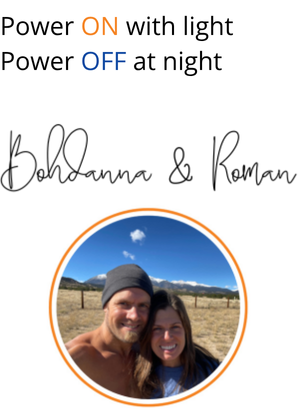
WANT TO REDUCE EMF IN YOUR LIFE?
Improve sleep, increase focus, and boost metabolism...
Don't live zapped. Live with zest!

